
 |
![]()
|
The Varsity Boat Club 
|
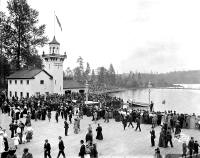
|
The Varsity Boat Club was established in 1910 under Hiram Conibear. That year Conibear had taken over the Coast Guard exhibit on Lake Union after the Alaska Yukon Expedition had closed - "secured by Coach Conibear as training quarters for the crew..." according to the VBC logs - and the men needed an organization to cover the shared costs. Thus was born the VBC. UW and HRF Photos | |
|
||
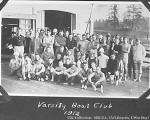 |
The team lived there through 1918, weathering the Pacific Northwest winters together in a building originally built as a temporary exhibit (and the thin walls reflected it) for the fair. Next door, in the former Tokyo Tea Room, George Pocock built shells and the women's locker room was set up. (More on this decade is here - Washington Rowing History - Men: 1910's and here - Washington Rowing History - Women: 1910's.) Throughout these times the team grew in strength and numbers. Strong, lifelong bonds were made, bonds that would lead to Rusty Callow saving Conibear's job at one point, and bonds that ultimately would save the program from extinction following Conibear's untimely death. This photo is from the scrapbook of A.C. Campbell, picturing the men together, on the landing of the VBC boathouse, in 1912. VBC Collection: UW21869z. |
|
|
||
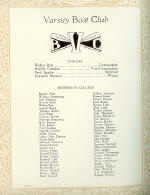
|
Some familiar faces in the 1924 Varsity Boat Club, including Thomas Bolles, Harold Condon, Fred Spuhn, Harrison "Stork" Sanford, Donald Grant, Harry John Dutton, and a young Alvin Ulbrickson. Tyee Photo. | |
|
||
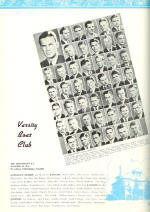 |
The 1936 VBC, including a photo in the lower right corner of the house they rented and lived in together. Tyee Photo. | |
|
||
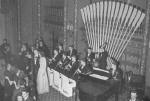 |
The 1941 Varsity Boat Club Dance. The VBC dance was a prime occasion in the 30's and 40's, attracting large crowds, held in the Spanish Ballroom at the Olympic Hotel, and featuring top entertainment. The event was scheduled in early January, immediately preceding full-time training, and was attended by alums, friends, and - of course - the students. Here Dave Ross's Orchestra plays against the traditional backdrop of sweeps. Tyee photo. | |
|
||
 |
VBC Commodore Skip John raises the VBC flag over the shellhouse to dedicate their new living quarters. Fil Leanderson and Dick Wahlstrom, with the support of freshman coach Stan Pocock, initiated the effort during spring break of 1953 that ultimately led to crew members living at the shellhouse year around. "Stan was the Freshman coach at that time and I was on his squad," said Doug Clarke, class of '56. "Stan was also the advisor to the VBC and suggested the idea to the officers just before spring break in 1953. I was one of the people who moved in (and I lived there for the entire four years that I was at the UW.) Stan arranged for the bunks and their delivery... we had bunks on the porch and in one of the inner rooms of the shellhouse, and hired a friend of my mother named Carmelia MacNichols (Stan didn’t quite get her name right in his autobiography) — a wonderful Italian cook who prepared lunch and dinner during the week, while we made our own breakfasts and fended for ourselves on the weekend." Tyee photo. | |
|
||
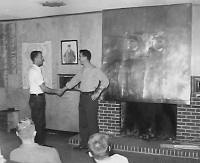 |
Skip John and Fil Leanderson in the VBC Lounge in 1953. That same photo of Hiram Conibear hung on that wall in the exact same place for five decades (see photo below). To the left is the letter board, to the right the copper VBC fireplace hood that provided the backdrop for countless events, dances... and the annual freshman head shaving ceremony. Tyee Photo. | |
|
||
 |
The 1968 VBC with a cameo by Conibear. Out of the sixties came some of the strongest bonds of fellowship among the men - bonds that exist just as strongly today. Tyee Photo. | |
|
||
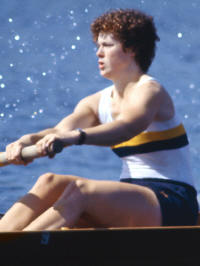
|
On March 17th, 1977, the first women's team rowers and coxswains became members of the Varsity Boat Club. Women's varsity rowing - established under Title IX in 1975 - was growing, and VBC membership was a logical extension in that growth. Kathy Bulger, junior captain of the team, led the women in their efforts to join; after meeting resistance from the men, Dick Erickson stepped in to moderate and facilitate the transition, noting that changing the organization of the VBC was easier than he originally thought, saying, "The amazing thing about that is there were only three references to gender in the entire constitution... only a couple of words had to be changed." The men and women met in a series of meetings that led to the induction of sixteen new female members into the VBC on March 17, 1977. "I am looking forward, with a lot of hope" to the future of the VBC said Bulger, pictured here (far left), and with her 1977 teammates... the majority in this photo being the first women's team members of the Varsity Boat Club. Kathy Bulger (Kate Camber) and VBC photos | |
|
||

|
In the 1970's, the men and women sold programs at the football games to raise money for the VBC. VBC funds were used to upgrade equipment, to purchase turnout gear, and for social events. The Husky Crew jacket worn in the far left photo is known as a "VBC Jacket", earned by all athletes rowing at Washington four quarters or more. VBC Photos | |
|
||
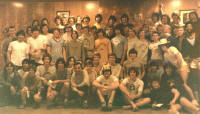 |
The Class of '82 in March of 1979 on freshman initiation night. Hiram Conibear exactly where he should be, copper VBC fireplace, and the letterman board... with more names, this time with men and women (see below) combined. The late Blake Nordstrom - later to become one of the most influential Rowing Stewards in the history of the program - is in the middle of this freshman photo, kneeling, yellow t-shirt with blue collar. Brad Schock photo |
|
|
||
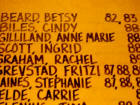 |
The 80's were a decade of transition, yet the VBC continued to serve a central role in the life of the athletes. The "W" board in the old shellhouse, written on the maple walls, was a testament to the tradition and legacy of the VBC. Eric Cohen photo. | |
|
||
 |
Men and women of the VBC, on the docks celebrating together, 1992. UW Athletics photo. | |
|
||
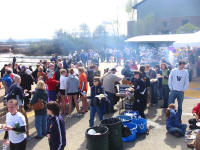
|
Class Day remains the most tradition-filled weekend of the year, held in March with multiple events including from top: the Class Day BBQ; the Class Day cruise (listing to port as spectators watch the races); the annual VBC Banquet (with the traditional copper fireplace hood prominently displayed below the Husky Clipper); and the women's alumni row. HRF Photos | |
|
||
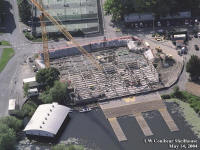
|
The same affinity and camaraderie - built a century ago - still exists today. The renovation of the shellhouse in 2004 would not have happened if not for the vast network of men and women VBC members who offered help, and the current strength of the alumni organization supporting the team is a testament to the strength of the VBC and the lifelong connection that is made while rowing at Washington. The VBC is at the same time a reflection of that unique shared experience - and an organization that preserves it. HRF Photos |
| Home | Contact Us | © 2001 - 2023 Washington Rowing Foundation |